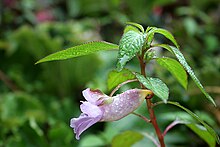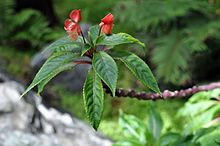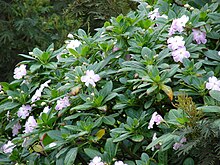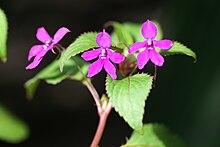Spring herbs
| Spring herbs | ||||||||||||
|---|---|---|---|---|---|---|---|---|---|---|---|---|

Greater balsam ( Impatiens noli-tangere ), illustration |
||||||||||||
| Systematics | ||||||||||||
|
||||||||||||
| Scientific name | ||||||||||||
| Impatiens | ||||||||||||
| L. |
The spring herbs ( Impatiens ) are one of the two genera within the family of the balsamic plants (Balsaminaceae). There are about 1000 species in this family. Hydrocera , the second genus of the family, contains only one species.
description
Impatiens species are usually annual or perennial herbaceous plants from 5 cm to 2.5 meters in size. The stem is usually fleshy to succulent. Some species form woody trunks. The leaves are simple and mostly serrated or curved. Extra-floral nectaries are often present, but stipules are missing.
The hermaphrodite flowers are zygomorphic . The calyx consists of five, not fused sepals, two of which are extremely reduced in most species. In most species, a sepal has been transformed into a petal-like spur in which the nectar is produced. Only one group of Malagasy species has completely reduced the spur. The crown also consists of five petals, the two lateral ones of which are fused together. There is only one circle with five stamens . The stamens are fused together, forming a "cap" which is above the upper permanent ovary sits. The style is short or absent and ends in one to five scars . At the beginning the flowering is in the male phase, after one to several days the overgrown stamens fall off and the female phase begins. This prevents self-pollination in most species.
The capsule fruits are tensioned by the pressure of the cell sap and can tear explosively when touched at pre-formed seams. The seeds are thrown out into the environment ( juice pressure spreader ). This is where the botanical name comes from: Impatiens (Latin) means "impatient, intolerant". The same cause also has the name "touch-me-not-an" of the great balsam ( Impatiens noli-tangere ).
All species of the genus are slightly poisonous when fresh.
Flower biology
The genus Impatiens is characterized by its large variety of flower shapes. Traditionally, a distinction is made between two types of flowers, one with a sagging (sacculate) spur with more or less prominent lower and upper lip, and one with a thread-like (filiform) spur, in which the petals form a flat plane and the spur is evenly narrow and quite long. However, in addition to these two types, there are a number of intermediate forms. In addition, there are more than 120 species in Madagascar without a spur that do not belong to either of the two types. A number of species also have two spurs. It therefore makes more sense to classify the species based on their pollinator groups: such as bees and bumblebees, butterflies, moths, flies and nectar birds. In some species from Madagascar, obligatory Kleistogamy is also common. Most species, however, rely on the activity of pollinators to produce sufficient seeds. However, many species are self-compatible. Many species of the temperate latitudes, as well as some tropical species, which under normal circumstances depend on the activity of pollinators for sufficient seed production, have the ability to form celestogamous flowers when there is a lack of light or nutrients.
distribution
Spring herbs are native to Africa , Eurasia and North America . Two species ( Impatiens turrialbana, I.mexicana ) occur in isolated areas in Central America. The greatest biodiversity can be found in the tropical and subtropical mountainous countries of Central Africa, Madagascar , the Himalayas, the Western Ghats (SW India) and Southeast Asia. In Europe there is only one species, the great balsam ( Impatiens noli-tangere ) originally native. Several other species are firmly naturalized as neophytes .
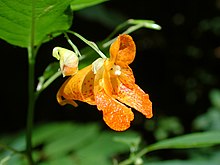


Types (selection)
There are about 1000 species in the genus Springkräuter ( Impatiens ). Here is a selection:
- Impatiens acaulis Arn. : It occurs in India and Sri Lanka.
- Impatiens acmanthera Hook. f. : It occurs in Sikkim .
- Impatiens aganantha Hook. f. : It occurs in Sikkim .
- Impatiens anaimudica C.EC fish. : It occurs in Kerala .
- Impatiens angustiflora Hook. f. : It occurs in India and Bhutan.
- Impatiens annulifera Hook. f. : It occurs in India.
- Impatiens arguta Hook. f. & Thomson : It occurs in India, Bhutan, Nepal, Myanmar, Xizang and Yunnan.
- Impatiens assurgens Baker : It occurs in Angola, Mozambique, Tanzania, Zambia, Malawi, Burundi and DR Congo .
- Impatiens aurella Rydb. : It was first described from North America.
- Balfour's balsam ( Impatiens balfourii Hook f. ): Originally it only occurs in the western Himalayas and is naturalized in Europe, especially in France, Spain, Italy and southern Switzerland.
- Balsam, Balsam Balsam ( Impatiens balsamina L. ): It is native to India, China and the Malay peninsula, widely planted ornamental plant is locally naturalized in Europe
- Impatiens barbieri Hook. f. : It occurs in India.
- Impatiens bequaertii De Wild. : It occurs in Rwanda, Burundi, DR Congo and Uganda.
- Impatiens bhaskarii J.RNDessai, L.Joseph & Janarth. : It occurs in India.
- Impatiens bicaudata H. Perrier : It occurs in Madagascar.
- Impatiens bicornuta Wall. : It occurs in India and in Nepal.
- Impatiens bivittata Hook. f. : It occurs in Sikkim .
- Impatiens bracteata Colebr. ex Roxb. : It occurs in India.
- Impatiens bracteolata Hook. f. : It occurs in India.
- Impatiens briartii De Wild. & T.Durand : It occurs in Tanzania, Uganda, Angola, Zambia, Burundi and DR Congo.
- Impatiens burtonii Hook. f. : It occurs in three varieties in Kenya, Uganda, Tanzania, Rwanda, Burundi, DR Congo and Cameroon.
- Orange-red balsam ( Impatiens capensis Meerb. , Syn .: Impatiens biflora Walter ): It is originally widespread in eastern North America and naturalized in Europe, for example along the Rhine and its tributaries.
- Impatiens cathcartii Hook. f. : It occurs in Bhutan and India.
- Impatiens chinensis L .: It occurs in two varieties in India, Bangladesh, Bhutan, Myanmar, Thailand, Vietnam, Malaysia and in China and is an Africa neophyte.
- Impatiens clavata Bhaskar : It was first described from India.
- Impatiens cothurnoides C.EC fish. : It occurs in India.
- Impatiens crenata Bedd. : It occurs in the Indian states of Kerala and Tamil Nadu .
- Impatiens cryptoneura Hook. f. : It occurs in Malaysia.
- Impatiens dalzellii Hook. f. & Thomson : It occurs in India.
- Impatiens dasysperma Wight : It is found in India.
- Impatiens decipiens Hook. f. : It occurs in India and in Xizang.
- Impatiens dendricola C.EC fish . : It occurs in the Indian state of Karnataka .
- Impatiens discolor DC. : It occurs in India, Bhutan and Nepal.
- Impatiens diversifolia B. Heyne ex Wight & Arn. : It occurs in India.
- Impatiens drepanophora Hook. f. : It occurs in India, Bhutan and Nepal.
- Colorful balsam ( Impatiens edgeworthii Hook. ): It is native to India, Bhutan, and Nepal. It occurs as a neophyte in small areas of Thuringia and Saxony-Anhalt.
- Impatiens elianae Abrah. & Eb.Fisch .: Endemic to Madagascar
- Impatiens exilis Hook. f. : It occurs in India, Bhutan and Nepal.
- Impatiens falcifera Hook. f. : It occurs in India and Nepal.
- Impatiens filicornu Hook. f. : It occurs in Togo, Congo, Cameroon, Equatorial Guinea, Gabon and DR Congo.
- Impatiens flaccida Arn. : It occurs in India and Sri Lanka and is a neophyte in Mauritius and Reunion.
- Impatiens florigera C.B. Clarke ex Hook. f. : It occurs in India and Bhutan.
- Impatiens gamblei Hook. f. : It occurs in India, Nepal and China.
- Impatiens gammiei Hook. f. : It occurs in India.
- Impatiens gardneriana Wight : It occurs in India.
- Impatiens gesneroidea Gilg : It occurs in two varieties in Uganda, Rwanda, Burundi and DR Congo.
- Glandular or Indian balsam ( Impatiens glandulifera Royle , Syn .: Impatiens roylei Walpers ): It originally only occurs in the Himalayas and is a widespread neophyte in Europe and North America , which occurs in large numbers and can displace the native flora.
- Impatiens gossweileri G.M. Schulze : It occurs in two subspecies in Angola, Congo, Gabon and DR Congo.
- Impatiens graciliflora Hook. f. : It occurs in India and in Nepal.
- Impatiens hians Hook. f. : It occurs in two varieties in Cameroon, Equatorial Guinea, Gabon and DR Congo.
- Impatiens hobsonii Hook. f. : It occurs in India and in Nepal.
- Impatiens hochstetteri Warb. : It occurs in four subspecies in tropical and southern Africa.
- Impatiens humilis Hook. f. : It occurs in Sikkim .
- Impatiens infundibularis hook. f. : It occurs in India and Bhutan.
- Impatiens irvingii Hook. f. : It occurs in tropical Africa.
- Impatiens johnii E. Barnes : It occurs in the Indian state of Kerala .
- Impatiens jurpia Buch.-Ham. : It occurs in India, Bhutan, Nepal, Bangladesh and Myanmar.
- Impatiens keilii Gilg : It occurs in two subspecies in Tanzania, Rwanda, Burundi and in the Democratic Republic of the Congo.
- Impatiens kingii Hook. f. : It occurs in India and Bhutan.
- Impatiens kleiniformis Sedgw. : It occurs in the Indian state of Karnataka .
- Impatiens laevigata Wall. : It occurs in India, Nepal and Myanmar.
- Impatiens latiflora Hook.f. & Thomson : It occurs in India and Bhutan.
- Impatiens latifolia L .: It occurs in India.
- Impatiens lawii Hook. f. & Thomson : It occurs in the Indian state of Karnataka.
- Impatiens laxiflora Edgew. : It occurs in India, Nepal and Bhutan.
- Impatiens lemannii Hook.f. & Thomson : It occurs in two subspecies in Pakistan, Afghanistan and India.
- Impatiens leptocarpa Hook. f. : It occurs in India.
- Impatiens letouzeyi Gray-Wilson : It occurs in Cameroon.
- Impatiens longipes Hook. f. & Thomson : It occurs in India, Nepal, Bhutan and Myanmar.
- Impatiens macrocarpa Hook. f. : It occurs in the Indian state of Kerala.
- Impatiens macroptera Hook. f. : It occurs in Nigeria, Cameroon, Gabon and Equatorial Guinea.
- Impatiens mannii Hook. f. : It occurs in Uganda, Cameroon, Congo, Equaterial Guinea, Gabon and DR Congo.
- Impatiens mendoncae G.M. Schulze : It occurs in Angola and in Congo.
- Impatiens mildbraedii Gilg : It occurs in two subspecies in Kenya, Uganda, Rwanda, Burundi and in the DR Congo.
- Impatiens minimiflora Hook. f. : It occurs in Sikkim.
- Impatiens minor (DC.) Bennet : It occurs in India.
- Impatiens niamniamensis Gilg : It occurs in tropical Africa.
- Great balsam , don't touch me ( Impatiens noli-tangere L. ), is common in Eurasia and a neophyte in North America.
- Impatiens nummulariifolia Hook. f. : It occurs in India.
- Impatiens occultans Hook. f. : It occurs in India and Nepal.
- Impatiens oppositifolia L .: It occurs in India and Sri Lanka.
- Impatiens pantlingii Hook. f. : It occurs in Sikkim.
- Small balsam or small-flowered balsam ( Impatiens parviflora DC. ), Originally only found in Asia (Central Asia) and has been naturalized in Europe since 1830.
- Impatiens phlyctidoceras Bullock : It occurs in Kenya and Uganda.
- Impatiens porrecta Wall. : It occurs in India and Nepal.
- Impatiens prainii Hook. f. : It occurs in India, Bhutan and Nepal.
- Impatiens puberula DC. : It occurs in India, Bhutan and Nepal.
- Impatiens pulcherrima Dalzell : It occurs in India.
- Impatiens pulchra Hook. f. & Thomson : It occurs in India, Bhutan, Myanmar and Nepal.
- Impatiens purpureoviolacea Gilg : It occurs in Rwanda, Burundi and DR Congo.
- Impatiens quisqualis Launert : It occurs in Malawi.
- Impatiens racemosa DC. : It occurs in India, Nepal, Bhutan, Myanmar, Thailand, Malaysia, Xizang and Yunnan.
- Impatiens radiata Hook. f. : It occurs in India, Bhutan, Myanmar, China and Nepal.
- Impatiens raziana Bhaskar & Razi : It occurs in India.
- Impatiens rosea Lindl.
- Impatiens scabrida DC. : It occurs in Pakistan, India, Nepal and Bhutan.
- Impatiens scabriuscula B. Heyne ex Wall. : It occurs in India.
- Impatiens scapiflora B. Heyne ex Roxb. : It occurs in India.
- Impatiens scitula Hook. f. : It occurs in India and Bhutan.
- Impatiens serratifolia Hook. f. : It occurs in India and Nepal.
- Impatiens shirensis Baker f. : It occurs in Malawi.
- Impatiens sodenii Engl. & Warb. The species originally comes from tropical East Africa and is wild in some parts of Central and South America.
- Impatiens spirifera Hook. f. & Thomson : It occurs in China, India, Nepal and Bhutan.
- Impatiens stenantha Hook. f. : It occurs in India, Nepal and Bhutan.
- Impatiens stocksii Hook.f. & Thomson : It was first described from India.
- Impatiens stuhlmannii Warb. : It occurs in two varieties in Kenya, Uganda, Rwanda, Burundi and DR Congo.
- Impatiens sulcata Wall. : It occurs in Pakistan, India, Nepal, Xizang and Bhutan.
- Impatiens sylvicola Burtt Davy & Greenway : It occurs in Malawi, Mozambique, Zimbabwe and in South Africa.
- Impatiens talbotii Hook. f. : It occurs in India.
- Impatiens tenella B. Heyne ex Wight & Arn. : It occurs in India.
- Impatiens textorii Miq. : It occurs in China, Japan, Korea and in Far Eastern Asian Russia.
- Impatiens thomsonii Hook. f. : It occurs in two subspecies in Afghanistan, Pakistan and India.
- Impatiens tomentosa B. Heyne : It occurs in India.
- Impatiens trichocladon Hook. f. : It occurs in Sikkim.
- Impatiens trilobata Colebr. : It occurs in India, Bangladesh and Myanmar.
- Impatiens tripetala Roxb. ex DC. : It occurs in India, Bangladesh, Nepal and Bhutan.
- Impatiens tropaeolifolia handle. ex Hook. f. : It occurs in India.
- Impatiens tuberculata Hook.f. & Thomson : It occurs in India and Bhutan.
- Impatiens tuberosa H.Perrier : It occurs in Madagascar.
- Impatiens tubifera B. Heyne ex Roxb. : It occurs in Sikkim.
- Impatiens turrialbana Donn.Sm. : It occurs in Costa Rica and Panama.
- Impatiens tweedieae E.A. Bruce : It occurs in Kenya and Uganda.
- Impatiens uncipetala C.B. Clarke ex Hook. f. : It occurs in India and in Nepal.
- Impatiens urticifolia Wall. : It occurs in India, Nepal and Bhutan.
- Impatiens villosocalcarata Warb. & Gilg
- Hard-working Lieschen ( Impatiens walleriana Hook. F. ): Originally only found in Tanzania and Mozambique. Many varieties of ornamental plants were bred from it. The species is naturalized in many tropical areas of Asia, Australia and Central and South America.
- Impatiens wallichii Hook.f. : It occurs in India and in Nepal.
- Impatiens warburgiana G.M. Schulze & R.Wilczek : It occurs in Rwanda and in the DR Congo.
- Impatiens zombensis Baker : It occurs in Malawi and Mozambique.
More pictures
Variety of diligent Lieschens ( Impatiens walleriana )
Glandular balsam on jumping up
swell
- Yilin Chen, Shinobu Akiyama, Hideaki Ohba: Balsaminaceae : Impatiens , p. 43 - online with the same text as the printed work , In: Wu Zheng-yi, Peter H. Raven, Deyuan Hong (eds.): Flora of China. Volume 12: Hippocastanaceae through Theaceae , Science Press and Missouri Botanical Garden Press, Beijing and St. Louis 2007. ISBN 978-1-930723-64-1
- Walter Erhardt, Erich Götz, Nils Bödeker, Siegmund Seybold: The great pikeperch. Encyclopedia of Plant Names. Volume 2. Types and varieties. Eugen Ulmer, Stuttgart (Hohenheim) 2008, ISBN 978-3-8001-5406-7 .
Individual evidence
- ^ Lens, F., Eeckhout, S., Zwartjes, R., Smets, E., Janssens, S .: The multiple fuzzy origins of woodiness within Balsaminaceae using an integrated approach. Where do we draw the line? In: Annals of Botany . tape 109 , 2012, p. 783-799 .
- ↑ C. Gray Wolson: Impatiens of Africa . AA Balkema, Rotterdam 1980, ISBN 978-90-6191-041-1 .
- ↑ Fischer, E., Rahelivololona, ME, Abrahamczk, S .: Impatiens galactica (Balsaminaceae), a new species of section spurless Trimorphopetalum from Madagascar . In: Phytotaxa . tape 298 , 2017, p. 269-276 .
- ↑ Abrahamczyk, S., Lozada-Gobilard, S., Ackermann, M., Fischer, E., Krieger, V., Redling, A., Weigend, M .: A question of data quality - Testing pollination syndromes in Balsaminaceae . In: PLoS One . tape 12 , no. 10 , 2017, p. e0186125 .
- ↑ Lozada-Gobilard, S., Weigend, M., Fischer, E., Janssens, S., Ackermann, M., Abrahamczyk, S .: Breeding systems in Balsaminaceae in relation to pollen / ovule ratio, pollination syndromes, life history and climate zone . In: Plant Biology . 2018, doi : 10.1111 / plb.12905 .
- ↑ a b c d e f g h i j k l m n o p q r s t u v w x y z aa ab ac ad ae af ag ah ai aj ak al am an ao ap aq ar as at au av aw ax ay az ba bb bc bd be bf bg bh bi bj bk bl bm bn bo bp bq br bs bt bu bv bw bx by bz ca cb cc cd ce cf cg ch ci cj ck cl cm cn co cp cq cr cs ct cu cv cw cx cy cz da db dc dd de df dg dh di dj Impatiens in the Germplasm Resources Information Network (GRIN), USDA , ARS , National Genetic Resources Program. National Germplasm Resources Laboratory, Beltsville, Maryland. Retrieved September 26, 2017.
- ↑ Abrahamczyk, S., Fischer, E .: Impatiens elianae (Balsaminaceae), a new species from central Madagascar, with notes on the taxonomic relationship of I. lyallii and I. trichoceras . In: Phytotaxa . tape 226 (1) , 2015, pp. 83-91 .

